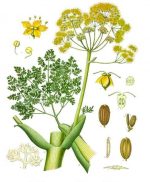 Native to the mountains of Iran and Turkmenistan, this herbaceous perennial is a member of the parsley family, Apiaceae, that also includes carrots, celery, and poison hemlock. Growing from a thick taproot, the plant is about 3′ tall and has a smooth, hollow stem. It has finely divided tripinnate leaves with a stout basal sheath clasping the stem. In late spring umbels of small yellow flowers appear and produce seeds that ripen in summer. A fetid yellowish-brown gum resin called galbanum is produced by the stem of the plant and is valued for its medicinal qualilties. In addition, the gum resin was used by the ancient Egpyptians and Israelites as an ingredient in incense. The genus name, Ferula, is the Latin word for the hollow light rod made from this plant and used for walking stick, splints, stirring boiling liquids, and corproral punishment. The specific epithet, galbaniflua, comes from the Semitic word galbana, the gum resin produced by the plant and the Latin word fluo meaning flow suggesting the way it emerges from a wounded stem.Type: Herbaceous perennial
Native to the mountains of Iran and Turkmenistan, this herbaceous perennial is a member of the parsley family, Apiaceae, that also includes carrots, celery, and poison hemlock. Growing from a thick taproot, the plant is about 3′ tall and has a smooth, hollow stem. It has finely divided tripinnate leaves with a stout basal sheath clasping the stem. In late spring umbels of small yellow flowers appear and produce seeds that ripen in summer. A fetid yellowish-brown gum resin called galbanum is produced by the stem of the plant and is valued for its medicinal qualilties. In addition, the gum resin was used by the ancient Egpyptians and Israelites as an ingredient in incense. The genus name, Ferula, is the Latin word for the hollow light rod made from this plant and used for walking stick, splints, stirring boiling liquids, and corproral punishment. The specific epithet, galbaniflua, comes from the Semitic word galbana, the gum resin produced by the plant and the Latin word fluo meaning flow suggesting the way it emerges from a wounded stem.Type: Herbaceous perennial
Bloom: Umbels of small yellow flowers in late spring
Size: 3.3′ H
Light: Full sun
Soil: Fertile, medium moist to dry, well-drained
Hardiness: Zones 5-9
Care: Make incisions in the stem to collect gum resin.
Pests and Diseases: Unavailable
Propagation: Fresh seed
Companion Plants: Other herbs such as rosemary, lavender, sage
Outstanding Selections: Not relevant
Photo Credit: Wikipedia